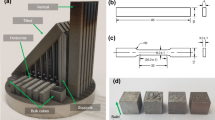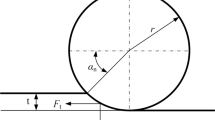Abstract
To explore the effect of weld geometry on irradiation-induced segregation and irradiation hardening, three different groove types of 316L austenitic stainless steel welds were studied in H+ with 5-MeV to a dose of 6.2 × 1017 ions/cm2 at 400 °C by means of Grazing incident X-ray diffraction, transmission electron microscope, energy-dispersive X-ray spectroscopy and nano-indentation technology. The results show that there was no new phase in three weld geometries after ion irradiation. A smaller heat input made the grain structure of the double U-groove weld smaller, and the surface void size was the smallest after irradiation. The higher grain density and grain boundary density made solute atoms more uniform and less segregated during diffusion, so that the weld had better mechanical properties. It is a feasible idea and method to refine the weld grain by double U-groove welding, so as to improve the irradiation-induced segregation resistance of the weld.











Similar content being viewed by others
References
Johnson D C, Kuhr B, Farkas D, and Was G S, Scr Mater 116 (2016) 87.
Alamo A, Bertin J L, Shamardin V K, and Wident P, J Nucl Mater 367–370 (2007) 54.
Nishiyama Y, Onizawa K, Suzuki M, Anderegg J W, Nagai Y, Toyama T, Hasegawa M, and Kameda J, Acta Mater 56 (2008) 4510.
Konobeev Y V, Dvoriashin A M, Porollo S I, and Garner F A, J Nucl Mater 355 (2006) 124.
Messina L, Schuler T, Nastar M, Marinica M-C, and Olsson P, Acta Mater 191 (2020) 166.
Jin H-H, Hwang S S, Choi M J, Lee G-G, and Kwon J, J Nucl Mater 513 (2019) 271.
Chopra O K, and Rao A S, J Nucl Mater 409 (2011) 235.
Fujii K, and Fukuya K, J Nucl Mater 469 (2016) 82.
Lin X, Peng Q, Han E-H, Ke W, and Jiao Z, Mater Charact 151 (2019) 396.
Lin X, Peng Q, Han E-H, Ke W, Sun C, and Jiao Z, Scr Mater 149 (2018) 11.
Ziegler J, Biersack J, and Littmark U, The Stopping Range of Ions in Matter, Pergamon Press 1 (1985), p 93.
Liu H, Wei Y, Tan C K I, Ardi D T, Tan D C C, and Lee C J J, Mater Charact 168 (2020) 110574.
Bonny G, Konstantinovic M J, Bakaeva A, Yin C, Castin N, Mergia K, Chatzikos V, Dellis S, Khvan T, Bakaev A, Dubinko A, and Terentyev D, Acta Mater 198 (2020) 1.
Liu Z Y, He B, Qu X, Niu L B, Li R S, and Wang F, Chin Phys B 28 (2019) 114.
Tschopp M A, Horstemeyer M F, Gao F, Sun X, and Khaleel M, Scr Mater 64 (2011) 908.
Okamoto P R, and Wiedersich H, J Nucl Mater 53 (1974) 336.
Allen T R, Busby J T, Was G S, and Kenik E A, J Nucl Mater 255 (1998) 44.
Okamoto P R, and Rehn L E, J Nucl Mater 83 (1979) 2.
Fukuya K, and Fujii K, J Nucl Sci Technol 46 (2009) 744.
Toyama T, Nozawa Y, Van Renterghem W, Matsukawa Y, Hatakeyama M, Nagai Y, Al Mazouzi A, and Van Dyck S, J Nucl Mater 418 (2011) 62.
Russell K C, Prog Mater Sci 28 (1984) 229.
Mattucci M A, Cherubin I, Changizian P, Skippon T, and Daymond M R, Acta Mater 207 (2021) 116702
Badji R, Chauveau T, and Bacroix B, Mater Sci Eng A 575 (2013) 94.
Zhang X, Mei X, Cao X, Wang Y, Sun J, and Zheng P, J Nucl Mater 509 (2018) 496.
Acknowledgements
This work is supported by the National Natural Science Foundation of China under Grant Nos. 51875264.
Author information
Authors and Affiliations
Corresponding author
Additional information
Publisher's Note
Springer Nature remains neutral with regard to jurisdictional claims in published maps and institutional affiliations.
Rights and permissions
Springer Nature or its licensor (e.g. a society or other partner) holds exclusive rights to this article under a publishing agreement with the author(s) or other rightsholder(s); author self-archiving of the accepted manuscript version of this article is solely governed by the terms of such publishing agreement and applicable law.
About this article
Cite this article
Qiao, Y., Lei, Y., Yao, Y. et al. Effect of Weld Geometry on Irradiation-Induced Segregation Resistance of 316L Stainless Steel Weld at 400 °C. Trans Indian Inst Met 77, 809–819 (2024). https://doi.org/10.1007/s12666-023-03178-8
Received:
Accepted:
Published:
Issue Date:
DOI: https://doi.org/10.1007/s12666-023-03178-8




